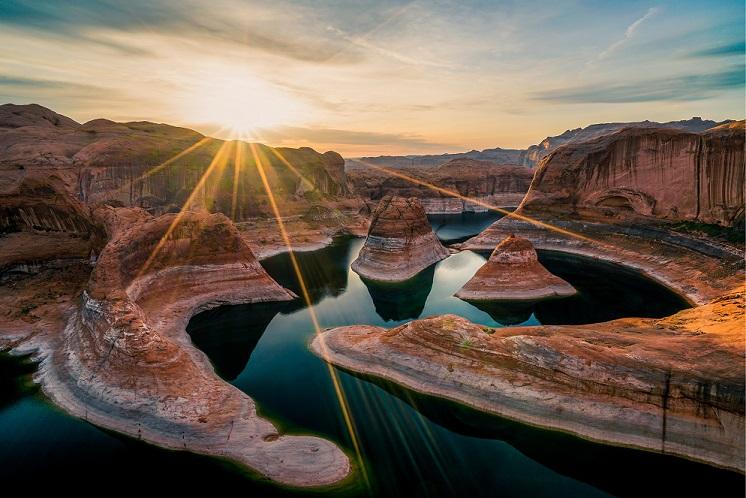Things to Do at Lake Powell
Boating
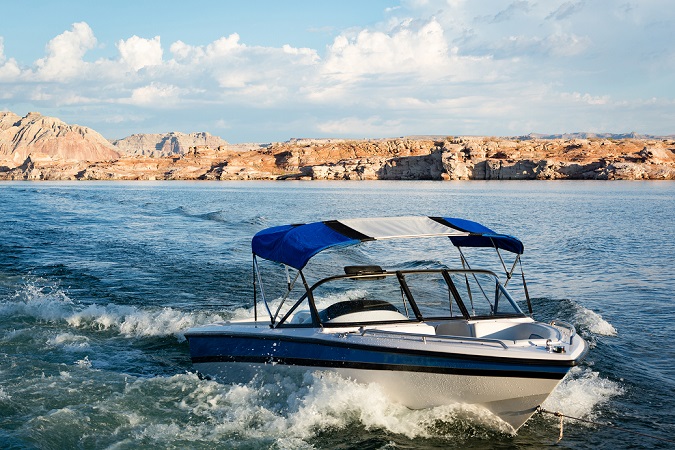
One of the most popular things to do at Lake Powell is hopping into a boat and cruising around! Whether you like being pulled on water skis or just riding along in the boat, it’s a great way to spend a day on the water.
Lake Powell is a huge body of water, so there is room for lots of boats. But be aware that speedy sport boats share the water with slow or sometimes stationary fishing boats. Stay alert and watch out for others.
Those who camp overnight from their boats must anchor on the shore. Campers often try to find a sandy beach or secluded cove to set up camp. You can refuel your boat at many of the marinas around the lake.
Fishing

Fishing is another popular Lake Powell activity. Striped bass is one of the more popular species to go after, but there are a wide variety of other fish to catch too. Be sure to check current regulations for fishing licenses, take-home limits, etc.
Swimming

On a hot summer day, who can resist a dip in the cool clear waters of Lake Powell? The water temperature can actually get quite warm during the summer months, topping out at over 80 degrees fahrenheit in the peak of the summer! But it’s still very refreshing compared to the summer heat out of the water.
Lake Powell offers a variety of beach areas designated for swimming, but no lifeguards are on duty.
Hiking and Exploring
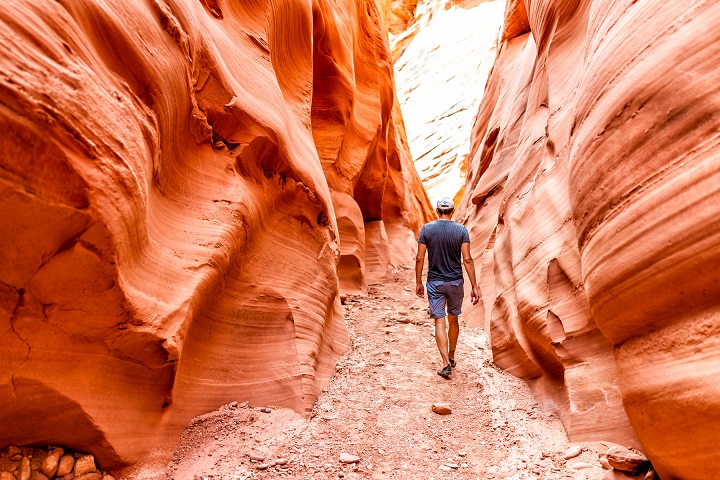
While activities on the water are tons of fun, don’t forget about all the exploring that is available on land. Lake Powell is surrounded by some great hiking trails and secluded slot canyons.
The desert sandstone contrasted against the blue water on the lake makes for some beautiful views.
Marinas in San Juan County
The main marina on the San Juan County side of Lake Powell is Halls Crossing marina. Other popular marinas are Wahweap, Antelope Point, and Bullfrog.
Halls Crossing

A variety of services are available at Halls Crossing Marina, at the end of Highway 276. Halls Crossing has a boat launch, gas station, grocery store, campground, beach access, and regularly scheduled ferry service on the Charles Hall Ferry. The ferry provides service to Bullfrog Marina where passengers can continue on Highway 276.
Halls Crossing is named for Charles Hall, who built the ferry used by Hole-in-the-Rock pioneers in 1880. Now 35 miles upstream from its original location, Halls Crossing can be reached by taking Highway 276 from the intersection of Highway 95 near Natural Bridges National Monument.
Hite
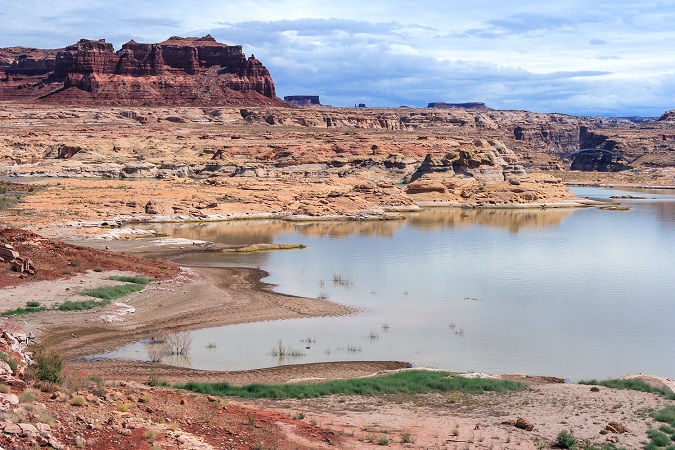
At the northernmost end of the lake sits Hite Marina, accessible via Highway 95. There are currently no services available in Hite, and water levels are too low to launch boats, but the remote marina is especially popular for anglers.
River rafting down Cataract Canyon from Moab to Hite is a popular and thrilling adventure. Hite Crossing Bridge is the only bridge that spans Lake Powell. The two-lane bridge signifies the lake’s upstream limit and continues Highway 95 toward Blanding.
Lake Powell Lodging
Houseboats

A fun way to stay at Lake Powell is a houseboat rental! Wahweap and Bullfrog marinas offer rentals for a variety of different houseboats. There are designs for every type of visit, from large family parties to relaxing little leisure boats. The houseboats have beds, seating, a bathroom and kitchen area; it’s all you need for a multi-day Lake Powell visit.
For more information on Lake Powell houseboat rentals, check out LakePowell.com.
Camping
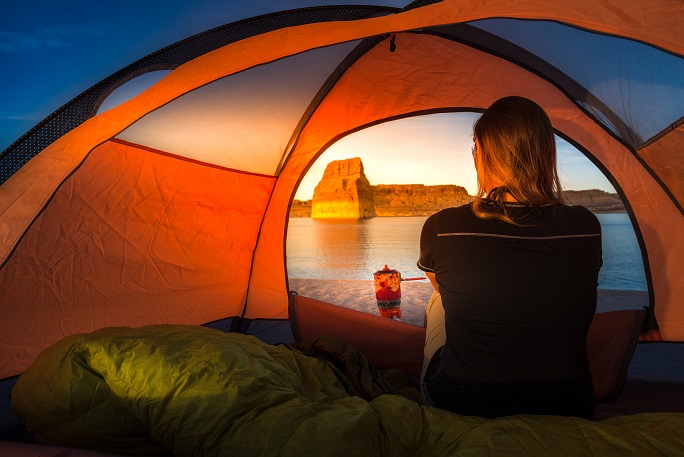
Of course, camping is another way to stay at the lake. There are some designated camping areas scattered around the Lake Powell region, and some campers choose to set up a tent on shore near the water.
There’s nothing more beautiful than crawling out of your tent in the morning to a glowing sunrise beaming through the canyon walls and onto the water.
Utah’s Canyon Country Lodging
As you start getting further to the east, away from the lake, you can find a variety of great lodging options in the main communities of Utah’s Canyon Country. These lodging options are great for those who would like to visit Lake Powell but would prefer to lodge in-town with more service and other attractions available.
The communities along Highway 191 such as Blanding, Bluff, and Monticello also offer a variety of dining options, shopping, and other services.
Other Things to Do Near Lake Powell
Rainbow Bridge National Monument
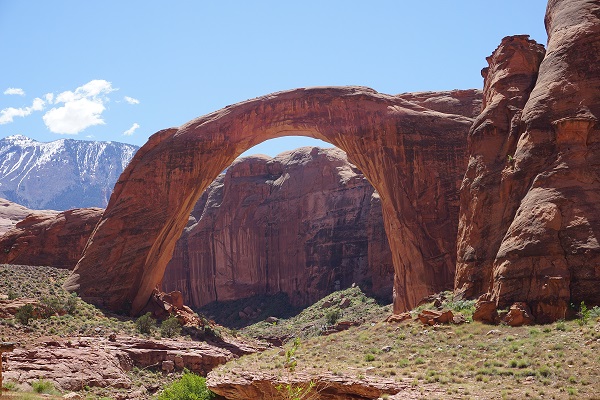
Many Lake Powell visitors also enjoy a day trip to Rainbow Bridge National Monument, a unique and secluded formation found in the desert to the east of the lake.
Rainbow Bridge is 290 feet high and spans 275 feet across. For reference, the U.S. Capitol building would fit beneath this towering structure! At the top of the arch, Rainbow Bridge is 42 feet wide and 33 feet thick.
More than 300,000 people around the world visit the monument each year, but Rainbow Bridge holds an especially sacred place in local Native American culture. Ancient Puebloans named the bridge Nonnezoshe, which means “rainbow turned to stone.”
While it's possible to hike to Rainbow Bridge through Navajo lands (multi-day backpacking trip- permit required), most visitors arrive by boat. The boat ride to Rainbow Bridge takes about 7-8 hrs round-trip from Wahweap Marina in Page, AZ, and includes a 1.25-mile hike from Bridge Canyon wharf.
Although located in the Navajo Nation, Rainbow Bridge National Monument is administered by the National Park Service-Glen Canyon National Recreation Area.
San Juan River
The San Juan River offers fishing, kayaking and floating expeditions. Permits are required for private trips on the San Juan, and there are regulations to adhere to. Make sure to get your permit and plan activities accordingly.
If you’d prefer, you can go with a guide and sit back and enjoy the spectacular red rock scenery, wildlife, and archaeological sites as you float down this mostly calm river with the occasional thrill of a Class II or Class III rapid.
Get more information about visiting the Central Region of Utah’s Canyon Country
